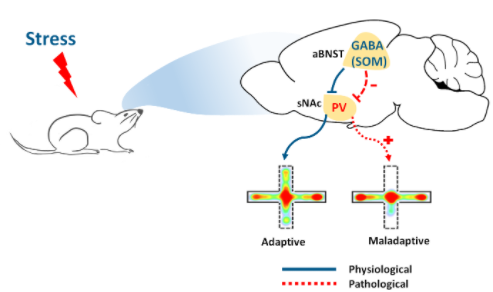RV virus was used for retrograde tracing to analyze upstream regions that innervate NAcPV neurons. GCaMP6m virus was used for fiber photometry to confirm the impact of different neuron types on anxiogenic information processing. (all viruses were packaged by
BrainVTA)
The viruses used in this article From BrainVTA are in the table below
|
RV |
R01002 RV-ENVA-ΔG-DsRed |
|
Tracing Helper |
PT-0165 rAAV-EF1α-DIO-TVA-EGFP-WPRE-hGH polyA
PT-0023 rAAV-EF1α-DIO-RVG-WPRE-hGH polyA |
|
Calcium sensors |
PT-0283 AAV9-DIO-GCaMP6m |
Pub Date: 2019-06-18,
DOI: 10.1038/s41380-020-0816-3 Email: [email protected]
Qian Xiao , Xinyi Zhou , Pengfei Wei , Li Xie , Yaning Han , Jie Wang, Aoling Cai , Fuqiang Xu , Jie Tu , Liping Wang
The prevailing view is that parvalbumin (PV) interneurons play modulatory roles in emotional response through local medium spiny projection neurons (MSNs). Here, we show that PV activity within the nucleus accumbens shell (sNAc) is required for producing anxiety-like avoidance when mice are under anxiogenic situations. Firing rates of sNAc
PV neurons were negatively correlated to exploration time in open arms (threatening environment). In addition, sNAc
PV neurons exhibited high excitability in a chronic stress mouse model, which generated excessive maladaptive avoidance behavior in an anxiogenic context. We also discovered a novel GABAergic pathway from the anterior dorsal bed nuclei of stria terminalis (adBNST) to sNAc
PV neurons. Optogenetic activation of these afferent terminals in sNAc produced an anxiolytic effect via GABA transmission. Next, we further demonstrated that chronic stressors attenuated the inhibitory synaptic transmission at adBNST
GABA → sNAc
PV synapses, which in turn explains the hyperexcitability of sNAc PV neurons on stressed models. Therefore, activation of these GABAergic afferents in sNAc rescued the excessive avoidance behavior related to an anxious state. Finally, we identified that the majority GABAergic input neurons, which innervate sNAc
PV cells, were expressing somatostatin (SOM), and also revealed that coordination between SOM- and PV- cells functioning in the BNST → NAc circuit has an inhibitory influence on anxiety-like responses. Our findings provide a potentially neurobiological basis for therapeutic interventions in pathological anxiety.
 Fig.1 GCaMP-based fiber photometry recording and RV virus tracing to study monosynaptic GABAergic inputs to sNAcPV neurons.
Fig.1 GCaMP-based fiber photometry recording and RV virus tracing to study monosynaptic GABAergic inputs to sNAcPV neurons.
To gain a circuit-level understanding of anxiety-like behavior in both healthy and pathological anxiety models, GCaMP-based fiber photometry recording (From
BrainVTA), genetically modified virus tracing (From
BrainVTA) and both optogenetic and chemogenetic neuronal manipulations were applied to address this question. The result showed that the functional connection between BNST and NAc increases in the state of anxiety. Inhibitory projections from adBNST attenuated sNAc PV neurons on the chronically stressed mice, and thus, activation of these inhibitory inputs from adBNST to sNAc rescued the excessively anxious state of the stressed mice.
BrainVTA offers viral vector construction & virus packaging services for AAV, LV, RABV, PRV, HSV and VSV that help researchers explore questions about genes, neurons, circuitry structure, function of brain network, mechanism and treatment of diseases.
If you have any needs, just email us at
[email protected].

